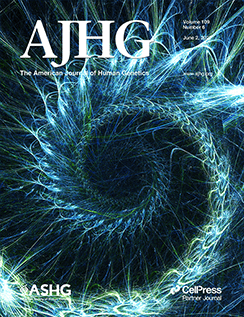A non-syndromic orofacial cleft risk locus links tRNA splicing defects to neural crest cell pathologies.
IF 8.1
1区 生物学
Q1 GENETICS & HEREDITY
引用次数: 0
Abstract
Orofacial clefts are the most common form of congenital craniofacial malformation worldwide. The etiology of these birth defects is multifactorial, involving genetic and environmental factors. However, in most cases, the underlying causes remain unexplained, precluding a molecular understanding of disease mechanisms. Here, we integrated genome-wide association data, targeted resequencing of case and control cohorts, tissue- and cell-type-specific epigenomic profiling, and genome architecture analyses to molecularly dissect a genomic locus associated with an increased risk of non-syndromic orofacial cleft. We found that common and rare risk variants associated with orofacial cleft intersect with an enhancer (e2p24.2) that is active in human embryonic craniofacial tissue. We mapped e2p24.2 long-range interactions to a topologically associated domain harboring MYCN, DDX1, and CYRIA. We found that MYCN and DDX1, but not CYRIA, are required during craniofacial development in chicken embryos. We investigated the role of DDX1, a key component of the tRNA splicing complex, in cranial neural crest cells (cNCCs). The loss of DDX1 in cNCCs resulted in the accumulation of unspliced tRNA fragments, depletion of mature intron-containing tRNAs, and ribosome stalling at codons decoded by these tRNAs. This was accompanied by defects in both global protein synthesis and cNCC migration. We further showed that the induction of tRNA fragments is sufficient to disrupt craniofacial development. Together, these results uncovered a molecular mechanism in which impaired tRNA splicing affects cNCCs and craniofacial development and positioned MYCN, DDX1, and tRNA processing defects as risk factors in the pathogenesis of orofacial clefts.一个非综合征性口面部裂风险位点将tRNA剪接缺陷与神经嵴细胞病理联系起来。
颅面裂是全球最常见的先天性颅面畸形。这些先天缺陷的病因是多因素的,涉及遗传和环境因素。然而,在大多数情况下,其根本原因仍未得到解释,从而无法从分子角度了解疾病的发病机制。在这里,我们整合了全基因组关联数据、病例和对照队列的靶向重测序、组织和细胞类型特异性表观基因组剖析以及基因组结构分析,从分子上剖析了与非综合征性口裂风险增加相关的基因组位点。我们发现,与口面裂相关的常见和罕见风险变异与一个在人类胚胎颅面组织中活跃的增强子(e2p24.2)相交。我们将 e2p24.2 的长程相互作用映射到了一个包含 MYCN、DDX1 和 CYRIA 的拓扑相关域。我们发现鸡胚胎颅面发育过程中需要 MYCN 和 DDX1,但不需要 CYRIA。我们研究了 DDX1 在颅神经嵴细胞(cNCCs)中的作用,DDX1 是 tRNA 剪接复合体的关键组成部分。颅神经嵴细胞中 DDX1 的缺失会导致未拼接 tRNA 片段的积累、成熟的含内含子 tRNA 的耗竭以及由这些 tRNA 解码的密码子处的核糖体停滞。与此同时,全局蛋白质合成和 cNCC 迁移也出现了缺陷。我们进一步发现,诱导 tRNA 片段足以破坏颅面发育。这些结果共同揭示了 tRNA 剪接受损影响 cNCC 和颅面发育的分子机制,并将 MYCN、DDX1 和 tRNA 处理缺陷定位为口面部裂发病机制中的风险因素。
本文章由计算机程序翻译,如有差异,请以英文原文为准。
求助全文
约1分钟内获得全文
求助全文
来源期刊
CiteScore
14.70
自引率
4.10%
发文量
185
审稿时长
1 months
期刊介绍:
The American Journal of Human Genetics (AJHG) is a monthly journal published by Cell Press, chosen by The American Society of Human Genetics (ASHG) as its premier publication starting from January 2008. AJHG represents Cell Press's first society-owned journal, and both ASHG and Cell Press anticipate significant synergies between AJHG content and that of other Cell Press titles.

 求助内容:
求助内容: 应助结果提醒方式:
应助结果提醒方式:


